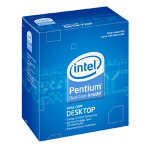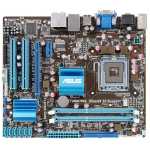System Buyers' Guide: PCs for Under $1000
by Sean Hollister on February 12, 2010 2:00 AM EST- Posted in
- Guides
Intel Entry-Level PC
From Pentium 4 to Pentium D, Core 2 Duo to Core 2 Extreme—not to mention the occasional Celeron and Xeon—Intel's LGA 775 socket has had a long, illustrious six years housing powerful processors. We're not going to write LGA 775's obituary quite yet, as Intel hasn't officially announced an end-of-life date for the aging socket. But with widespread availability of a mainstream successor in LGA 1156 and leaked Intel roadmaps depicting only the Pentium Dual-Core chips to continue through 2010, the writing's on the wall. If you buy an LGA 775 system today, don't expect to be able to easily upgrade its processor through retail channels next year.
However, none of that says an LGA 775 processor and motherboard can't be the base for a fantastic budget PC. LGA 775 chips have proven to be excellent overclockers, with many of the recent 45nm SKUs capable of reaching speeds up to 4GHz at stock voltage. They are mature and reliable; multiple AnandTech editors still use them in their home PCs, and clock for clock they continue to compete well against AMD's offerings (albeit at generally higher prices and/or lower core counts). And should you still want to upgrade at some point down the road, the aforementioned wide variety of compatible processors means that you may still find an opportunity to do so in the secondhand market.
| Intel Entry-Level System | ||
| Hardware | Component | Price |
| Processor | Intel Pentium Dual-Core E5300 (2.6GHz x2, 45nm, 2MB L2 Cache) |
$65 |
| Cooling | CPU Retail HSF | $0 |
| Video | Onboard | $0 |
| Motherboard | ASUS P5G43T-M Pro LGA 775 Micro ATX | $80 |
| Memory | G.Skill Ripjaws 4GB DDR3-1600 F3-12800CL9D-4GBRL | $105 |
| Hard Drive | WD Caviar Blue 500GB WD5000AAKS | $54 |
| Optical Drive | Sony Optiarc Model AD-7240S-OB 24X DVDRW SATA | $28 |
| Audio | Onboard | $0 |
| Case | Cooler Master Centurion 5 CAC-T05-UW Mid Tower ATX | $55 |
| Power Supply | OCZ ModXStream Pro 500W ATX12V SLI Certified, CrossFire Ready, 80 PLUS Certified Modular Active PFC (before $25 Rebate) | $65 |
| Base System Total | $452 | |
| Display | ASUS VW193TR Black 19" 5ms Widescreen LCD (1440 x 900) | $120 |
| Speakers | Built-in Monitor | $0 |
| Input | Microsoft B2L-00045 Comfort Curve Black USB Keyboard and Optical USB Mouse - OEM | $22 |
| Operating System | Microsoft Windows 7 Home Premium OEM 1-Pack (for System Builders) | $105 |
| Complete System Total | $699 | |
| Plus Estimated Shipping (within Continental U.S.) | $715 | |
| Rebates | -$25 | |
| Final Total (less tax, if applicable) | $690 | |
 |
Since December 2008, our CPU of choice for the Intel Entry-level PC has been the excellent Pentium Dual-Core E5200 Wolfdale: a 2.5GHz, $64 processor that hit a sweet spot in the price/performance ratio that no other Intel chip could match. Today, we're going to stray ever so slightly from our previous recommendation and suggest you pick up its bigger brother, the 2.6GHz Pentium Dual-Core E5300 instead. Why? Simply put, the $65 E5300 is the exact same chip, but with a 13x multiplier that immediately makes it 100MHz faster—for only $1 more. And considering that 13x multiplier also means a higher maximum overclock than that of the 12.5x E5200, we believe that extra $1 is money very well spent.
It's also important to note that since late 2009, new E5300 processors have been shipping with Intel's Virtualization Technology, or VT-x. If you're hoping to run the Windows XP Mode under Windows 7 Professional/Ultimate, you'll need this feature and you won't find it on the E5200. You can indeed find VT-x on the cheaper $60 Celeron E3400, but only in exchange for a significant drop in performance. On the other hand, if you're looking to spend even more on a processor and don't plan to overclock, you might consider the 2.8GHz E6300 for $80, which has guaranteed VT-x support and a 1066MHz (vs. 800MHz) FSB speed.
 |
With LGA 775 fading from the public eye, it was imperative that we find as capable and upgradable a motherboard as we could fit into our budget while such boards were still to be found. To that end, we chose the ASUS P5G43T-M Pro. At only $80, the P5G43T-M Pro features both the Intel G43 GMCH as well as the ICH10 Southbridge, allowing for acceptable video playback with the X4500 IGP and plenty of storage options, including a single IDE header and six SATA 3Gb/s ports. The board supports all LGA 775 processors up to the Core 2 Extreme series, 8GB of DDR3-1333 memory, and has excellent connectivity with VGA, DVI and HDMI ports, six USB 2.0 ports, Gigabit LAN and Realtek ALC887 8-channel HD audio, in addition to combo PS/2 and optical S/PDIF audio out. Onboard, there's a single PCIe x16 slot, a PCIe x1 slot and two PCI slots, as well as headers for six more USB 2.0 ports. There's no hardware RAID support, only a single chassis fan connector and you won't be playing new games or natively decoding H.264/VC-1/MPEG2 streams with the integrated X4500 graphics, but the P5G43T-M Pro's got a pretty solid layout with room to grow.
All other components are the same ones chosen for our AMD Entry-level PC, up to and including that 4GB of G.Skill DDR3-1600 memory. Even for an LGA 775 rig—where the majority of affordable motherboards use DDR2—we felt it didn't make financial sense to go with the slower modules when quality DDR3 is available for a marginal price increase, and can be repurposed if/when you build your next PC. However, if you're looking to squeeze out every last drop of value, you can pick up low-end DDR2-800 memory instead as with our AMD build. In that case, our motherboard recommendation is the ASRock G43Twins-FullHD (a similarly featured G43/ICH10 Micro ATX with separate DDR2 and DDR3 slots and a DVI/DisplayPort riser card) for $75. Just be aware that the G43Twins-FullHD uses jumper settings for its memory divider, so you'll need to check the manual in order to properly set the board for your memory.










86 Comments
View All Comments
PrinceGaz - Friday, February 12, 2010 - link
Unless you are building a HTPC or something else where form-factor is important, wouldn't a standard ATX mobo be a better option. Quite apart from the very useful additional PCI and PCIe sockets the ATX board will have which will allow the PC to be used for practically anything, there is generally room for more of other assorted headers like SATA and USB for adding further drivers and whatnot internally as well (and any decent ATX mid-tower will have plenty of 3.5" and 5.25" bays for them all).Admittedly I haven't checked prices for several years (mid 2005 when I built my current box, actually), ATX mobos were only a bit more expensive than uATX back then and I assume the same is true today. Even if you don't use most of the extra features, those you end up using at some point easily (for me) justify the small additional cost.
MatrixVPR - Friday, February 12, 2010 - link
It was recently brought to my attention that there is a really good Samsung HD that is the same size, same price and double the performance! In many cases it actually out performs the Raptors (which i have...)Samsung HD502HJ
I would post a link to the benchmarks but I'm not really sure if that's Kosher or not!?
SeanHollister - Friday, February 12, 2010 - link
As I mention to another commenter above, we were actually originally going to go for the Samsung HD502HJ, but not for the reason you suggest. Though benchmarks do show the Samsung having higher sequential read and write speeds than some contemporaries, it seems to suffer somewhat in access times and IOPS such that it's not much better (though certainly not worse) in real-world applications than the WD we chose.That doesn't keep me from wanting to test one for myself, though :-)
jdparker520 - Friday, February 12, 2010 - link
It's good to see some mention of a budget SSD (Intel X25-V), though it could really use the coverage and analysis of a full article. It's frustrating that this site only seems to cover the fastest and biggest SSDs that would almost double the cost of a reasonably configured system. What I'd like to see is a full comparison of the lower capacity drives in the 30-40GB range from the persepective of using it as a boot / application drive while storing user data on a traditional disk. This is what I'll be looking for in the next few months, but so far I haven't seen much information that would help guide my purchase.rivethead - Friday, February 12, 2010 - link
I too, was also glad to see a mention of an SSD in the upgrades section. The time has arrived.Anand did cover the Kingston 40GB SSD in a recent SSD article (which is the same thing as the Intel 40GB....same hardware, same controller, and now that you can flash the Intel firmware onto the Kingston....same firmware WITH TRIM). It compares very favorably to the bigger SSDs on random reads.
MadMan007 - Friday, February 12, 2010 - link
On pg 3 in the last paragraph you refer to the RAM as Corsair but the recommendation is G Skill.Good read, the options are many and while one can always find other viable options it's nice to have things narrowed down sometimes.
SeanHollister - Friday, February 12, 2010 - link
Thanks for catching that. We originally chose Corsair RAM, but they bumped the price of their modules $5 at the last minute.qwertymac93 - Friday, February 12, 2010 - link
I really wish this site would take a look at samsung hard drives, they are really cheap and the new f3 line is great. the samsung f3 1tb(which i now own :P) is one of, if not THE fastest 1tb hard drive, and is silent. i run my computer with no side panel on my desk, and i cannot hear it apart from initial spin up. It absolutely destroys my 320gb Seagate from a year and a half ago(:duh:). i think 1tb is the absolute lowest any builder should go today, you spend $20-30 more for twice as much size and better performance. I had a 160gb seagate for 5 years, and never thought I'd need more, then i got a 320gb and filled it in less then a year, my new 1tb is now half full(my 320 is pulling backup duty now), YOU CAN NEVER HAVE TOO MUCH!SeanHollister - Friday, February 12, 2010 - link
Funny you should mention that: we were originally going to go with a Samsung F3 500GB HD502HJ, but the retailers with the best price ran out of stock the day before the article went live.While it's true that newer hard drives are faster and quieter no matter the manufacturer, when you're comparing ones from the same generation at the same price point, it's hard to see a difference in real-life performance -- at least one big enough to justify spending extra on. :-)
Spivonious - Friday, February 12, 2010 - link
I'm curious why the E5300 was chosen, when the E3200 is just as capable and cheaper. I've been using it in my HTPC for 6 months and have yet to run into any slowness. It makes perfect sense in my mind for an entry-level non-gaming system.